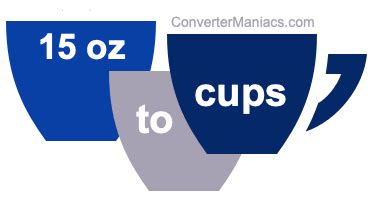How Many Cups Is In 15 Oz
Kalali
Mar 26, 2025 · 4 min read

Table of Contents
How Many Cups Are in 15 Oz? A Comprehensive Guide to Volume Conversions
Understanding volume conversions is crucial in various aspects of life, from cooking and baking to crafting and even scientific experiments. One common query revolves around the relationship between ounces (oz) and cups. Specifically, many people wonder: How many cups are in 15 oz? This comprehensive guide will not only answer that question definitively but will also delve into the nuances of volume measurements, offering you a complete understanding of how to confidently convert between ounces and cups and other units.
Understanding Ounces and Cups
Before diving into the conversion, let's clarify the units involved.
-
Ounces (oz): Ounces are a unit of weight in the imperial and US customary systems. However, in the context of liquid volume, we're referring to fluid ounces (fl oz). A fluid ounce measures volume, not weight, although the terms are often used interchangeably, leading to confusion.
-
Cups (c): Cups are a unit of volume commonly used in cooking and baking recipes. The size of a cup can vary slightly depending on the measuring cup used, but the standard US cup is defined as 8 fluid ounces (fl oz).
Calculating Cups in 15 Oz
Now, to answer the central question: How many cups are in 15 oz?
Since 1 US cup equals 8 fluid ounces, we can perform a simple calculation:
15 fl oz / 8 fl oz/cup = 1.875 cups
Therefore, there are 1.875 cups in 15 fluid ounces. This is equivalent to 1 and 7/8 cups.
Beyond the Basic Conversion: Factors Affecting Accuracy
While the calculation above provides a precise answer, it's important to consider factors that can affect the accuracy of your measurements in real-world scenarios:
1. Measuring Cup Variations:
Not all measuring cups are created equal. Some might be slightly larger or smaller than the standard 8-fluid ounce cup. This can introduce minor discrepancies in your conversions. Always use a standardized measuring cup for consistent results.
2. Ingredient Density:
The density of the liquid or substance you're measuring plays a role. A cup of water will have a different weight than a cup of honey or oil, even though they occupy the same volume. This means that a weight-based measurement (ounces) may not always translate directly to a precise volume-based measurement (cups). This is particularly relevant when dealing with ingredients like flour or sugar, which can be compacted differently, leading to variations in volume.
3. Temperature:
Temperature can also influence volume. Liquids expand when heated and contract when cooled. For highly accurate measurements, ensure your ingredients are at a consistent temperature.
4. Filling Method:
The way you fill your measuring cup also impacts accuracy. Level the cup to the brim without packing or shaking the ingredients. A slightly overfilled cup can lead to inaccurate conversions.
Practical Applications of the Conversion
Knowing how many cups are in 15 oz is valuable in numerous situations:
1. Cooking and Baking:
Many recipes specify ingredients in both cups and ounces. Being able to convert between the two ensures you use the correct amount of ingredients for consistent results.
2. Crafting and DIY Projects:
Various crafting projects require precise measurements of liquids or substances. Accurate conversions guarantee the success of your projects.
3. Scientific Experiments:
In scientific settings, precise volume measurements are essential. Converting between ounces and cups helps maintain accuracy in experiments that involve liquids.
Expanding Your Conversion Skills: Other Useful Conversions
Beyond converting 15 ounces to cups, it's beneficial to understand other relevant volume conversions:
Ounces to Milliliters (ml):
1 fluid ounce is approximately equal to 29.57 milliliters. This conversion is often needed when working with international recipes or scientific experiments.
Cups to Liters (l):
1 US cup is approximately equal to 0.2366 liters. This conversion is useful for scaling up recipes or working with larger volumes of liquids.
Tablespoons and Teaspoons:
Understanding the relationships between tablespoons, teaspoons, and cups (1 cup = 16 tablespoons = 48 teaspoons) is crucial for accurate baking and cooking.
Mastering Volume Conversions: Tips and Tricks
- Use a reliable conversion chart or calculator: Online resources and kitchen tools offer quick and easy conversion capabilities.
- Practice regularly: The more you practice conversions, the more comfortable and accurate you'll become.
- Understand the limitations of conversions: Always keep in mind that factors like density and temperature can affect the precision of your measurements.
- Double-check your work: Always review your calculations to ensure accuracy before proceeding with your recipe or experiment.
Conclusion: More Than Just a Conversion
The question of how many cups are in 15 oz is not just about a simple calculation; it's about understanding the complexities of volume measurement and its practical applications. By grasping the nuances of different units, considering influencing factors, and expanding your conversion skills, you’ll enhance your precision in various tasks, from culinary creations to scientific endeavors. Remembering that 15 fl oz equates to 1.875 cups is a valuable piece of knowledge, but understanding the underlying principles behind the conversion will empower you to confidently tackle any volume conversion challenge you encounter.
Latest Posts
Latest Posts
-
What Percent Is 5 Of 8
Mar 29, 2025
-
What Is 350 Degrees Celsius In Fahrenheit
Mar 29, 2025
-
How Many Cm In 33 Inches
Mar 29, 2025
-
45 Is What Percent Of 20
Mar 29, 2025
-
What Is 38 Degrees Centigrade In Fahrenheit
Mar 29, 2025
Related Post
Thank you for visiting our website which covers about How Many Cups Is In 15 Oz . We hope the information provided has been useful to you. Feel free to contact us if you have any questions or need further assistance. See you next time and don't miss to bookmark.
